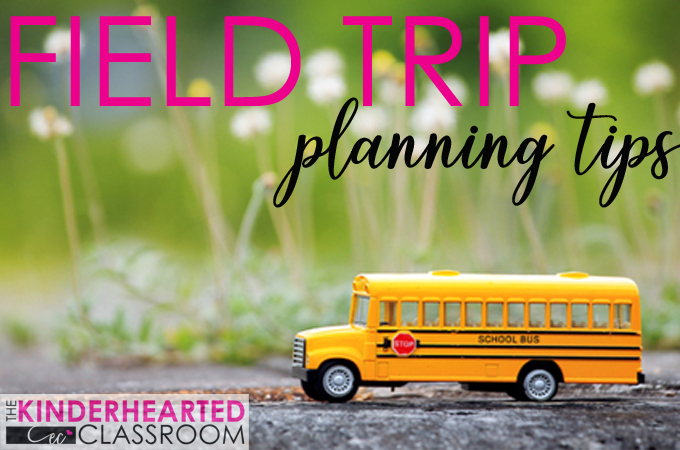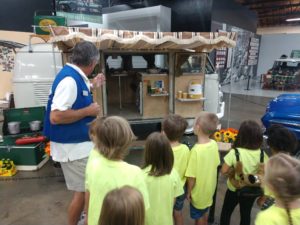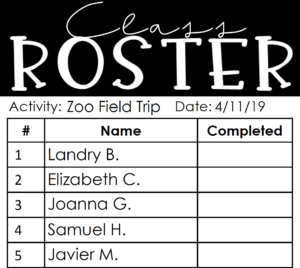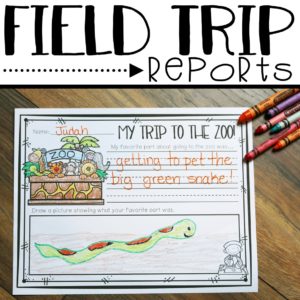We love sharing our favorite resources, books, classroom supplies and teacher stuff with you. When we do, we may earn money or products from the companies mentioned in this post. This does not affect our choices in what to recommend. Rest assured, we only recommend our favorite products to you! You can find our full advertising policy on the Partner With Elizabeth page.
I love field trips. Field trips are an excellent way to facilitate new learning, apply old learning, or connect learning to the real world. With a little pre-planning you can have Fabulous Field Trips!
One of my main goals as a teacher is to teach my students to love learning. The love of learning and the ability learn new things outside of a traditional classroom setting is a valuable life skill. So while I do have to structure much of our learning time inside the classroom, I love using field trips to supplement our learning opportunities.

I have planned my fair share of field trips over the years I want to share some of my tips and tricks with you. I’ve come along way from being that first year teacher that was a little {actually a LOT} nervous to take an entire class of kids out into the world. I hope that these tips will allow you to learn from my experiences and mistakes and jump right into creating your own fabulous field trips.
Planning is Key!
All field trips have one thing in common . . . a little planning will make the entire field trip go smoothly and more efficiently. If you are planning a field trip here are some important things to ask yourself and consider.
1. What is the learning objective of the field trip?
I always like to start here. What do I want my students to learn from this out of the classroom experience. After all, a field trip is more than just a fun outing. A field trip should give us the opportunity to connect our learning to real world experiences, give chances to apply our learning by doing something, or provide opportunities for learning something new.

2. What place can we go that will help us to meet our learning objective?
There are so many field trip options out there. Stuck on ideas, see the list below! Unless you are told where you field trip location will be, it’s important to make sure that your location lines up with your learning objective. If you don’t have a choice when deciding your field trip location, say for instance your school district tells you that all kindergarteners will go to the fire station, then make sure to set your learning objective so it lines up with the location. These two things should go hand in hand.
3. When can we go?
This may seem like a silly question, but there are lots of things to consider here. First, does your school have any rules about when you can or cannot leave campus. For example, a friend of mine works for a school where state testing days are considered closed campus days (meaning no one comes in and no one goes out). So even through her students were not testing, they could not schedule a field trip during this time. I also know of schools where no field trips can happen in the first 2 weeks or last 2 weeks of school. So, just make sure you are aware of your school or your district rules on when you can schedule a field trip.
You also have to make sure that the timing of the field trip works for your field trip destination. Many popular field trip destinations limit the number of groups on any given day. It important that you schedule your field trip with the destination and get on their schedule.
4. Do I need parents to help?

Most likely, the answer is YES! Even if you are just going to the park, extra hands and extra eyes are always helpful. But, it’s not just enough to consider how many parents you would like. Many field trip destinations have rules and requirements for the adult to child ratio. You must ask to find out if there is a specific number of adults you will need.
5. Do I need to arrange for transportation?

Unless you are within walking distance of your destination, you will likely need to arrange for transportation. If you are within walking distance make sure that walking is allowable by your school administration or district. To arrange transportation you will need to follow your specific school’s procedures. This might be as simple as making a request to the front office, or it might be as complicated as contacting the transportation office yourself. If you are at a small school or private school this might also include arranging for parents to act as drivers. Whatever the case, make sure that you get your transportation lined up as far in advance as possible.
6. Will there be a fee?
When you arrange your field trip it is important to find out what fee, if any, will be due to the location. Also, decide if this fee will be covered by your school or if this must be paid by the students. You also want to find out what types of payments they will accept. Many field trip destinations want one payment for the entire group – as opposed to collecting $2 from each student as they enter. Do they require a check or will they accept a purchase order from he school district? This will often require you to collect the fee in advance and coordinate with your school to get a check or purchase order. Sometimes this is a process that can take time, so make sure you are familiar with your particular process and give yourself plenty of time.
Notifying Parents and Permission Slips
Once you have the details of the date and time, location, fee and transportation lined up then you are ready to notify the parents of the upcoming field trip. Make sure that you notify parents will all the details of the trip. I like to notify parents and ask for volunteers about a month in advance. This allows parents ample time to make requests for time off from work if they want to attend. It also gives me time to follow-up if I need more volunteers, send reminders, and fill in missing chaperones with other campus staff members.
However, I generally don’t send out the permission slips until about 2 weeks in advance. This way, the field trip is near and fresh on everyone’s mind. However, I have found that giving myself a few extra days to collect this missing permission slips is very important. Trust me, you don’t want to be calling home the morning of the field trip because a permission slip was never turned in. There will be plenty else to do that morning. And you don’t want to face those teary eyes when you have to tell a student they cannot go because they don’t have a permission slip.
I use an editable Class Roster to keep track of who has turned in their permission slips and money. You can download it here for FREE! It’s super hand for field trips and so many other things throughout the year!
Field Trip Ideas
There are so many field trip possibilities, you are truly on limited by your imagination (and of course your school / school dsitrict rules). Here’s some field trip ideas to get you started in your planning:
- The Zoo or Aquarium
- The Fire Station or Police Station
- Local Museums (Children’s Museums / Science Museums are great for hands-on exploration)
- The Planetarium
- A Farm or Petting Zoo
- A Pumpkin Patch or Apple Orchard

- A Community Garden
- The Public Library
- The Supermarket, a Bakery or a local Restaurant
- A Dentist, Doctor or Vet’s Office
- The Post Office, Court House or other City Government Office
- The Beach or a Park (makes a great location for hands-on science)
- A local factory or industry business
- The Recycling Center

- The Symphony
- The Children’s Theatre
- A Local Sporting Event
- A TV Station, Radio Station or the Newspaper Office
- State or County Fair, Rodeo
- Local Historical Sites
The Week Before . . .
Field trip day is always exciting, but for the teacher it can be nerve wracking too. You are, after all, responsible for the safety of all your students and you are leaving the four walls of the school. During the week leading up to the field trip take some time to do some planning and instructing for your students. Not only will this help you be prepared, but it will also help your students to know what to expect and ease any anxiety they may be having too!
Before field trip day, think through the day. What will the students do? Will they have partners, small groups or stay together as a class? Will they rotate to different places or can they roam freely? Are there activities they must complete? How should they act? Who will they report to (the teacher, a parent, another staff member)?
Once you have through through this then it is time to share it with your students. Do this in advance, before field trip day. Talk about the behavior expectations. Practice the expected behavior and even demonstrate what behavior is NOT okay for this location. Talk about what they will see and the activities they will do. Model the activities or give instructions now so they will be prepared. Talk about who they be with that day (class together with the teacher, group of 5 students with a parent, etc.) and what to do if they get separated from the group. The more you can provide explicit instructions on what your students will do, and how they will do it, the smoother the day will go.
What if something goes wrong?
Things happen – and even the best planned field trips will have unexpected occurrences. Think through what might go wrong! I know, we don’t want to think about that, BUT – having a plan for the unexpected is very important. What if it rains, a student gets hurt or parents don’t show up? What if you spend 15 minutes waiting for the bus and the kids are bored? OK – so don’t go overboard thinking about the negatives – no need to plan for the Zombie Apocalypse. But being prepared for “What if ‘s” of the day can only help.
Time to Confirm
It’s also important during the week before a field trip to confirm a few things: confirm with the location, confirm with transportation, follow-up on the check or purchase order. Send reminders to parents about the field trip noting anything specific the students should wear or bring. Follow-up on missing permission slips and fees.
Get Yourself Ready
Last, a few days before the field trip start putting together everything you need for field trip day. I love carrying a backpack on field trip day. It gives me a place to put everything I have (permission slips, my phone, and the all important hand sanitizer) but it also keeps my hands free for holding hands and guiding students. Don’t wait til the last minute to get everything together. Field trip day is often a little hectic so anything you can do in advance will be very helpful!
Field Trip Day!
The day has finally arrived and everyone is excited. Double check your permission slips, remind your students of the expectations and grab your bag. Don’t forget your camera! You can enjoy the day because are planned, prepared and ready for a fabulous field trip. Unexpected issue – no problem – you’ve already thought about it. Have fun and enjoy the day with your students. Delight in their curiosity and help them learn to love learning.
Field Trip Follow-up
To me this is one of the most important steps of the learning process following a field trip, but often the one that is left out. The follow-up gives your students an opportunity to process the field trip, to connect their learning and expand on it. Make sure to set aside some time in the following days for field trip follow-up. Talk about the field trip in class. Give your students opportunities to develop their speaking skills and use vocabulary they learned as they describe, explain and articulate the day.
Let them write about the field trip. After each field trip, I always do a follow-up writing. This gives my students the opportunity to share their thoughts, make connections, and process the learning from the day. Doing the writing after we have a class discussion helps them to have already developed ideas, review vocabulary words or focused their thinking – all of which make writing easier. I created these Editable Field Trip Reports for this exact time.
These Field Trip Reports are editable which means you can quickly edit the page to match your field trip (or you can use the page that is already made). You can also give your students a specific writing prompt related to the field trip, or include some vocabulary words they can use in their writing.
This set of Editable Field Trip Reports includes themed writing pages for 15 different field trip themes. Additionally, each theme comes with two different writing lines (primary lines and regular lines) so it can be used with students from varying ages and abilities.
Once done, the students love sharing their writing. One of my favorite things to do is to take all of their writings and bind them together to create a class book about our field trip. The book then goes into our classroom library. The students LOVE, LOVE, LOVE reading it over and over again!
You can find the Editable Field Trip Reports in The Kinderhearted Classroom Store or on Teachers Pay Teachers.
So what are you waiting for? Get planning and get ready for a fabulous field trip!



